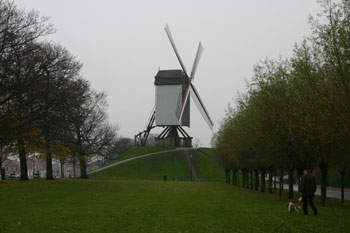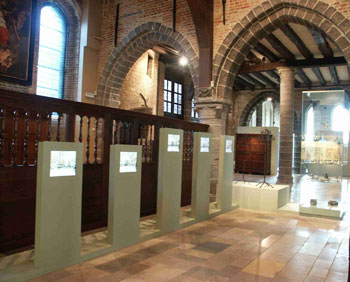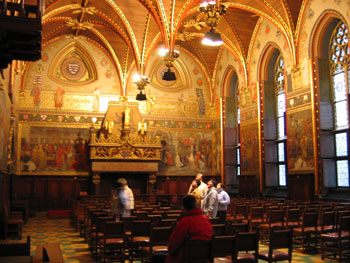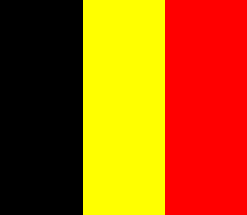Sunday 28 November 2004
Our
hopes for a bike tour today are immediately quashed once we wake up by the sound
of rain pouring down on the streets. It keeps on raining, so we have to abandon
the idea altogether. Instead of that we choose to explore the North
Eastern part of the old town by foot armed with an umbrella. The rain is a bit
of killjoy, but in this quiet part of the old town - away from the crowds - is
still interesting. We stroll along the Spiegelrei,  where once foreign merchants had their town houses. We pass the Jeruzalem
Church, once a family chapel, built in the 15th century as a copy of the Holy
Sepulchre church in Jerusalem. It is located next to the Lace
centre. Unfortunately both are closed on Sundays. Not so the Bruges museum
voor volkskunde (Folklore Museum), housed in a row of almshouses. It
consists of a series of period rooms focusing on industry and crafts. We carry
on to the edge of the old town where we find a group of windmills. The St Janhuismolen
is one of them and can be visited. We follow the city moats have a look at
the English Cloister (closed on Sunday) and return via the Spiegelrei to the Jan
van Eykplein. The middle of the square is taken by a statue of the
where once foreign merchants had their town houses. We pass the Jeruzalem
Church, once a family chapel, built in the 15th century as a copy of the Holy
Sepulchre church in Jerusalem. It is located next to the Lace
centre. Unfortunately both are closed on Sundays. Not so the Bruges museum
voor volkskunde (Folklore Museum), housed in a row of almshouses. It
consists of a series of period rooms focusing on industry and crafts. We carry
on to the edge of the old town where we find a group of windmills. The St Janhuismolen
is one of them and can be visited. We follow the city moats have a look at
the English Cloister (closed on Sunday) and return via the Spiegelrei to the Jan
van Eykplein. The middle of the square is taken by a statue of the  painter
who lived in Bruges for 11 years until his death in 1411. Here is also the toll
house from which the dukes of Luxembourg for centuries excercised their right to
levy tolls. The Toll house is 15th century, but was heavily medievalised
in the late 19th century.
The
rain keeps on pouring down as we head for the
Memling
museum. This museum is based in the St Janhospitaal. The buildings served as
a hospital for 800 years until it was converted into a museum in 1976. On the
one hand it displays artifacts and objects illustrating the history of the
hospital, on the other hand it is the place to look art by the painter Hans
Memling and his contemporaries. Memling (1433-93) was employed by the
hospital and painted several works especially for the hospital chapel. Main
attraction is the altarpiece for the hospital chapel, Mystical Mariage of St
Catherine, which was to offer relief for the patients and reconcile them with
their destiny in the afterlife. We have lunch in the Dagelijks Brood (Daily
Bread), a wholefood bakery and lunchroom, where we join the other guests at a
large communal table for delicious sandwich and quiche. painter
who lived in Bruges for 11 years until his death in 1411. Here is also the toll
house from which the dukes of Luxembourg for centuries excercised their right to
levy tolls. The Toll house is 15th century, but was heavily medievalised
in the late 19th century.
The
rain keeps on pouring down as we head for the
Memling
museum. This museum is based in the St Janhospitaal. The buildings served as
a hospital for 800 years until it was converted into a museum in 1976. On the
one hand it displays artifacts and objects illustrating the history of the
hospital, on the other hand it is the place to look art by the painter Hans
Memling and his contemporaries. Memling (1433-93) was employed by the
hospital and painted several works especially for the hospital chapel. Main
attraction is the altarpiece for the hospital chapel, Mystical Mariage of St
Catherine, which was to offer relief for the patients and reconcile them with
their destiny in the afterlife. We have lunch in the Dagelijks Brood (Daily
Bread), a wholefood bakery and lunchroom, where we join the other guests at a
large communal table for delicious sandwich and quiche.
In
the afternoon we visit the Stadhuis
(Town Hall) where the Gothic Hall is the pride of Bruges. The Hall was heavily
renovated in the 19th century and the frescoes, commissioned in 1895 illustrate
major events in Flemish history. The Renaissance Hall is more historical
and is housed in  the
neighbouring Brugse
Vrije (same ticket). It is the old Aldermen's room of Bruges with a very
interesting chimneypiece from 1531. It glorifies the life and works of emperor
Charles V. The name of Brugse Vrije refers to the Bruges liberties
and privileges that the city earned for itself, thus giving it a measure of
autonomy under series of kings through the centuries. All Bruges museums
can be visited on a combi ticket (a choice of 5 museums for €15). the
neighbouring Brugse
Vrije (same ticket). It is the old Aldermen's room of Bruges with a very
interesting chimneypiece from 1531. It glorifies the life and works of emperor
Charles V. The name of Brugse Vrije refers to the Bruges liberties
and privileges that the city earned for itself, thus giving it a measure of
autonomy under series of kings through the centuries. All Bruges museums
can be visited on a combi ticket (a choice of 5 museums for €15).
The
estaminet de Garre is only yards away from here in a tiny alleyway off the
Breidelstraat (easily missed) and offers a wide range of Belgian beers. We opt
for a sweet Kriek (cherry beer) and a Tripel van de Garre (strong Golden Ale).
At
night we eat at
the Vlaamsche
Pot. A tiny little restaurant with red chequered table cloths and
traditional Flemish dishes. I take the waterzooi with chicken, while Erik opts
for the Flemish stew. Friendly service. After dinner go for a walk looking at
the beautifully lit monumental buildings.
Weather:
rain, 10ºC/50ºF .
|

 where once foreign merchants had their town houses. We pass the Jeruzalem
Church, once a family chapel, built in the 15th century as a copy of the Holy
Sepulchre church in Jerusalem. It is located next to the
where once foreign merchants had their town houses. We pass the Jeruzalem
Church, once a family chapel, built in the 15th century as a copy of the Holy
Sepulchre church in Jerusalem. It is located next to the  painter
who lived in Bruges for 11 years until his death in 1411. Here is also the toll
house from which the dukes of Luxembourg for centuries excercised their right to
levy tolls. The Toll house is 15th century, but was heavily medievalised
in the late 19th century.
painter
who lived in Bruges for 11 years until his death in 1411. Here is also the toll
house from which the dukes of Luxembourg for centuries excercised their right to
levy tolls. The Toll house is 15th century, but was heavily medievalised
in the late 19th century.  the
neighbouring
the
neighbouring